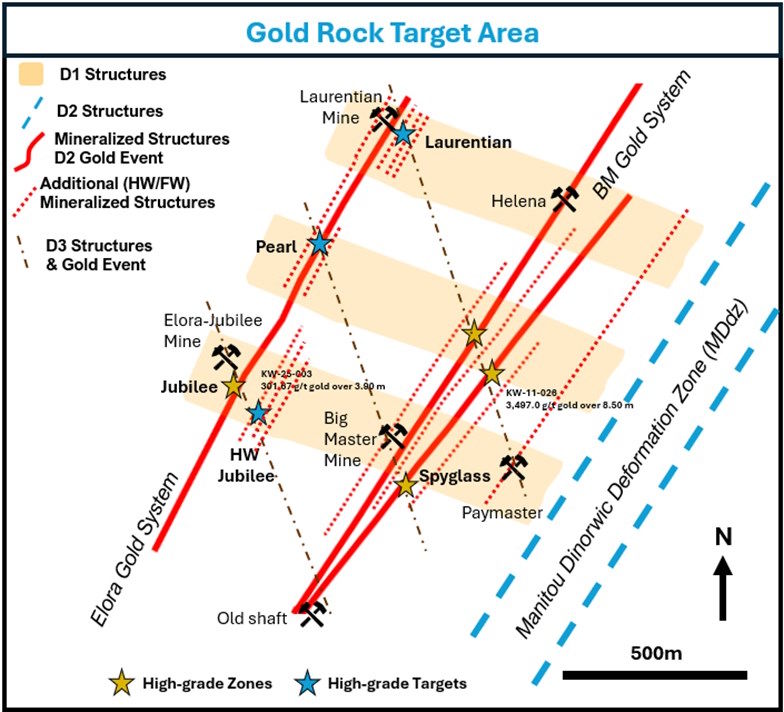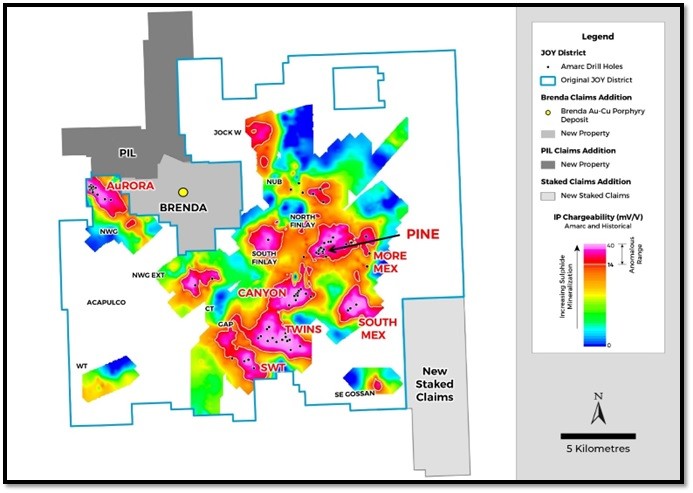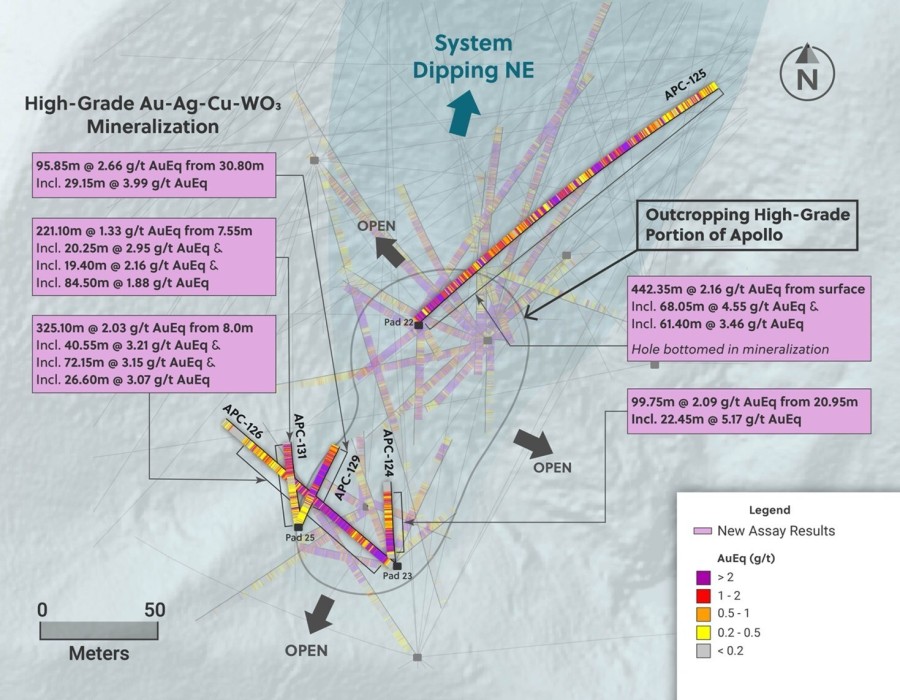VANCOUVER, BRITISH COLUMBIA – TheNewswire - June 6, 2025 – FITZROY MINERALS INC. (TSXV: FTZ, OTCQB: FTZFF) (“Fitzroy Minerals” or the "Company") is pleased to announce that diamond drill hole BRT-DDH022, in the Southwest Area at the Buen Retiro Copper Project (“Buen Retiro” or the “Project”), returned 110 m @ 1.94% Cu in oxide mineralization starting at 62 metres. Results from the ongoing drilling program support the large-scale and high-grade nature of the mineralizing system at Buen Retiro. Further drilling results from the North and South areas are reported below. The Project covers 13,240 ha and is located 57 km southwest of Copiapó, Chile.
Highlights:
-
Hole BRT-DDH022 intersected 110 m @ 1.94% Cu and 416 ppm Co from 62 m, including 58 m @ 3.06% Cu and 502 ppm Co from 97 metres.
-
Target minerals in BRT-DDH022 are predominantly leachable green copper oxides, tenorite, cuprite, and chalcocite.
-
Drilling to date has intersected mineralization on several distinct trends within a 1 km-wide x 4 km-long corridor, highlighting the scale of the mineralizing system at Buen Retiro.
Merlin Marr-Johnson, President and CEO of Fitzroy Minerals commented, "I am excited by the wide and high-grade intersection seen in BRT-DDH022 as it highlights the intensity of the copper mineralizing events at Buen Retiro. Combined with historical holes BRT-DDH006, BRT-DDH008 and BRT-DDH012, an emerging trend in the Southwest Area has a strike length of several hundred metres, returning good width intersections grading over 1% copper in oxides and leachable minerals, from surface. In addition, the presence of very high-grade, near-massive, cuprite and chalcocite feeder structures enhances the depth potential of copper mineralization at Buen Retiro.
Our near-term exploration efforts will continue to target near-surface copper mineralization within a 1 km-wide by 4 km-long corridor. The Buen Retiro Project is particularly well-suited to rapid development as the low-elevation, flat, desert area is the site of historical mining and it is located very close to significant infrastructure. In addition, the Company continues to test the Project’s potential for deeper copper mineralization."
Buen Retiro Copper Project, Chile
Phase 1 and Phase 2 Drilling Summary
Phase 1 drilling at Buen Retiro was carried out in 2023-2024, prior to the acquisition (the “Acquisition”) of Ptolemy Mining Ltd (“Ptolemy”) by Fitzroy Minerals. Results from Phase 1 drilling, which comprised 14 diamond drill holes (BRT-DDH001 to BRT-DDH014), are reported in the technical report titled “National Instrument 43-101 Technical Report for the Buen Retiro Copper Project” filed on 8 November 2024 by Fitzroy Minerals. The Phase 1 and Phase 2 programs are effectively seamless with Phase 2 being a continuation of the Phase 1 program that was completed by Ptolemy prior to the Acquisition. Company management and geologists have maintained custody of the drill core, continuity of the core shed, the geological team and the QA/QC practices.
Figure 1. Main copper mineralizing areas and drill results, Buen Retiro Copper Project.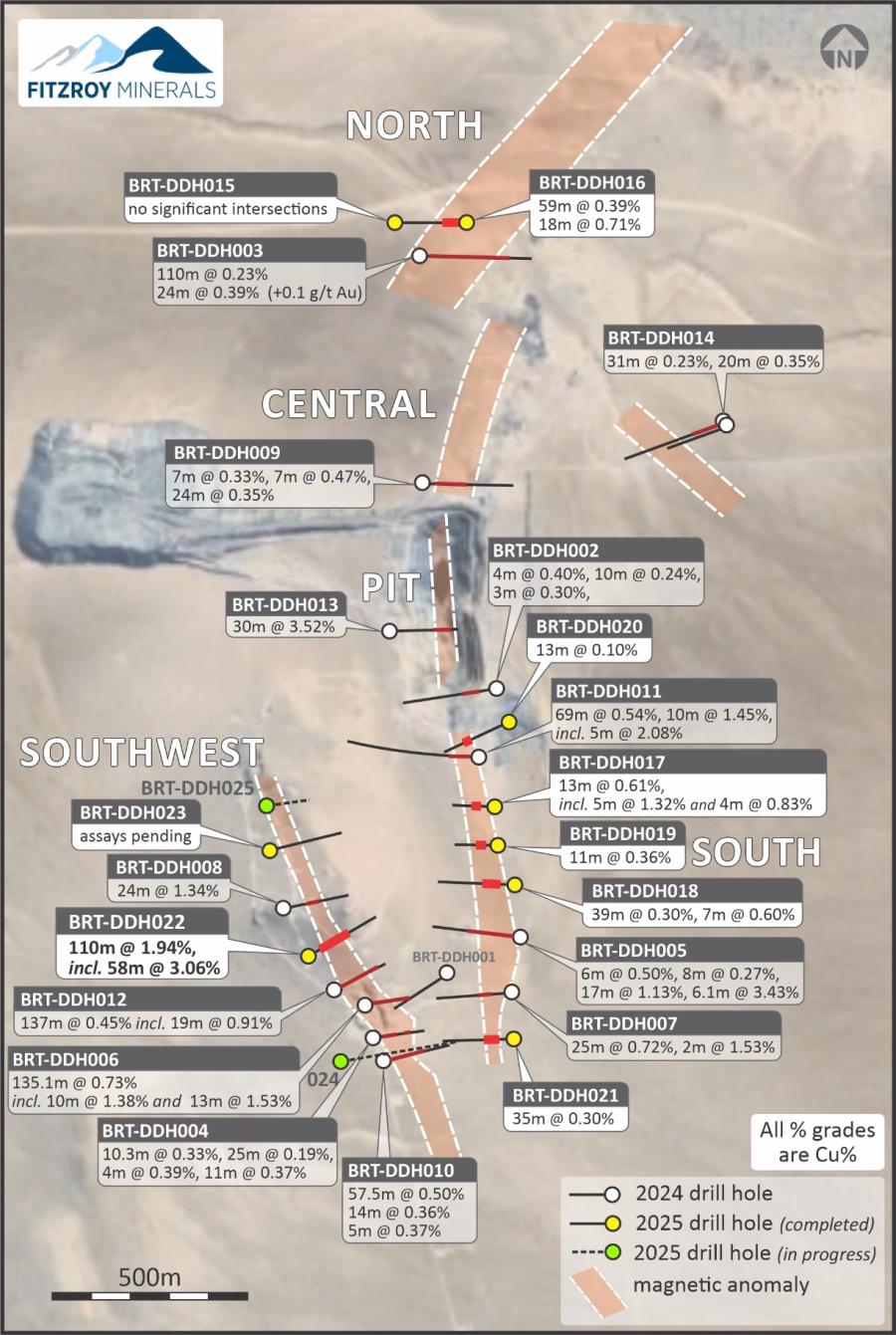
Nine holes have been completed in Phase 2 drilling at Buen Retiro, totalling 2,105 m to date and averaging hole lengths of about 234 metres. A second rig has been mobilized to site and holes BRT-DDH024 and BRT-DDH025 are currently being drilled. Assay labs in Chile are extremely busy, with Fitzroy Minerals experiencing turnaround times of approximately six weeks. Full assay results have been returned for holes BRT-DDH015 to BRT-DDH020, and some assays are awaited from holes BRT-DDH021 and BRT-DDH022. No assays have been returned for drill hole BRT-DDH023.
Fitzroy Minerals aims to drill at least 8,000 m in 2025 and is investigating a potential switch of one of the diamond drill rigs for a Reverse Circulation (RC) drill rig with the aim of accelerating exploration in the Central and Northern areas.
Assay Results and Mineralization
The best assay results on the Project to date, are from hole BRT-DDH022, which intersected 110 m @ 1.94% Cu and 416 ppm Co from 62 m, including 58 m @ 3.06% Cu and 502 ppm Co from 97 metres (Table 1). Target minerals visible in BRT-DDH022 comprise different types of green oxides (chrysocolla, atacamite and malachite), together with tenorite, cuprite, and possibly ionic copper in limonite, as well as minor native copper and chalcocite.
The geology of BRT-DDH022 is that of “typical” Punta del Cobre Iron-Oxide Copper Gold (IOCG) style, with highly brecciated and altered rock, often accompanied by magnetite, hematite, mushketovite, specularite, or jarosite matrix. The country rock is a sequence of andesitic volcanic rocks. Mineralization lies within breccias that show signs of strong hydrothermal alteration, massive sub-vertical hematite or magnetite veins varying from 0.5 m to 4.5 m thick, and frequent veinlets of tenorite. Occasionally the tenorite veins can reach thicknesses of up to 10 cm, which is the first time this feature has been seen at Buen Retiro. These zones, with semi-massive tenorite, mixed with atacamite, chrysocolla, and limonite, correspond with the highest grade intersections, reaching a maximum of 12.86% Cu (1.0 m sample). Hole BRT-DDH022 was drilled to a planned target length of 270 metres.
Table 1. Phase 2 drill core assay results*, Buen Retiro Copper Project, Copiapó, Chile.
|
Drill Hole |
EAST (m) |
NORTH (m) |
Azimuth /Dip |
From |
To |
Interval |
Copper |
Cobalt |
|
BRT-DDH015 |
345007 |
6923015 |
090/-45 |
No significant intersections |
||||
|
BRT-DDH0163 |
345195 |
6923015 |
270/-60 |
0 |
59 |
59 |
0.39 |
- |
|
Including |
19 |
37 |
18 |
0.71 |
- |
|||
|
BRT-DDH0173 |
345290 |
6921502 |
270/-49 |
102 |
115 |
13 |
0.61 |
- |
|
Including |
105 |
110 |
5 |
1.32 |
- |
|||
|
And |
170 |
174 |
4 |
0.83 |
- |
|||
|
BRT-DDH0183 |
345345 |
6921303 |
270/-48 |
15 |
54 |
39 |
0.30 |
- |
|
19 |
26 |
7 |
0.60 |
- |
||||
|
BRT-DDH0193 |
345299 |
6921403 |
270/-48 |
88 |
99 |
11 |
0.36 |
- |
|
BRT-DDH0203 |
345321 |
6921720 |
245/-45 |
165 |
178 |
13 |
0.10 |
- |
|
BRT-DDH0213 |
345352 |
6920903 |
267/-45 |
115 |
150 |
35 |
0.30 |
- |
|
BRT-DDH022 |
344818 |
6921115 |
063/-45 |
62 |
172 |
110 |
1.94 |
416 |
|
Including |
97 |
155 |
58 |
3.06 |
502 |
|||
|
BRT-DDH023 |
344712 |
6921381 |
075/-45 |
Assays pending |
||||
*Minimum thickness of 4 m and minimum average grade of 0.3% Cu.
1 True thickness is estimated to be 63% of drill hole interval.
2 True thickness is estimated to be 100% of drill hole interval.
3 True thickness is estimated to be 85% of drill hole interval.
In the North Area, hole BRT-DDH016, drilled towards the west, intersected 59 m @ 0.39% Cu from surface (collared in mineralization, under a thin layer of gravel). The North and Central areas are open in most directions: along strike, at depth, and to the east. Holes BRT-DDH017 to BRT-DDH021 were drilled in the South Area and intersected variable copper mineralization along an 800 m north-south trend, with mineralized intercepts varying in thickness from 11 to 39 m and grades ranging between 0.30% to 0.61% Cu.
At the far end of the South Area, hole BRT-DDH021 was located to the south of a magnetic anomaly. Partial assays have been returned for this hole to a length of 155 m, ending with 35 m @ 0.30% Cu. Assays for the remainder of the hole are pending. The results from BRT-DDH021 suggest that the north-south trend in the South Area trend remains open toward the south.
Discussion
Exploration in the Southwest Area, around hole BRT-DDH022, continues to extend the strike length of a northwest-southeast trend (Figure 1), with promising intersections that average 0.5% to 1.9% Cu in oxides and leachable minerals from surface, along with several high-grade copper intervals. The main magnetic anomaly that defines the northwest-southeast geophysical signature in the Southwest Area extends for over 1.5 km along strike and more than 500 m below the surface, close to the location of hole BRT-DDH022. Considering only the strike-length between BRT-DDH006 and BRT-DDH008, there exists a 270 m portion with considerable thicknesses that contain more than 1.0% Cu (Figure 1). In addition, the presence of very high-grade, almost massive cuprite and chalcocite feeder structures, enhances the depth potential of copper mineralization at Buen Retiro. Mineralization in BRT-DDH022 is interpreted to be the result of a sub-vertical structure that is steeply inclined to the east, and is located close to the centre of the main magnetic anomaly. The true thickness of the mineralized intercept in BRT-DDH022 is interpreted to be 63% of the reported mineralized interval. The copper mineralization in the Southwest Area is accompanied by cobalt that is currently unlikely to be recovered in the processing of oxide material but which could be a value-add metal should a sulphide processing plant ever be developed.
In the Northern Area, BRT-DDH015 was an inclined hole drilled towards the east, and located about 750 m north of the old mine pit. This hole was drilled sub-parallel to a shear zone that dips to the east and intersected largely weakly mineralized intrusive country-rock.
Hole BRT-DDH016 was drilled west towards the collar location of BRT-DDH015 (Figure 1), confirming that the hanging wall of the east-dipping shear zone is mineralized. Using data from existing drill hole records and hole BRT-DDH016, it is interpreted that the disseminated, largely tenorite, oxide hanging wall mineralization in the Northern Area is approximately 60 to 80 m wide and is open along strike to the northeast and down to the depth of oxides at approximately 80 metres (Figure 3). Magnetic data suggests that the shear zone continues to the northeast for a further 2-3 km and systematic exploration along this structure will determine the extent of mineralization along-trend. The true thickness of the mineralized intercept in BRT-DDH016 is interpreted to be the full reported interval as the drill hole is estimated to be almost orthogonal to mineralization.
Figure 2. Cross-Section, BRT-DDH022, Southwest Area Trend, Buen Retiro Copper Project, Chile.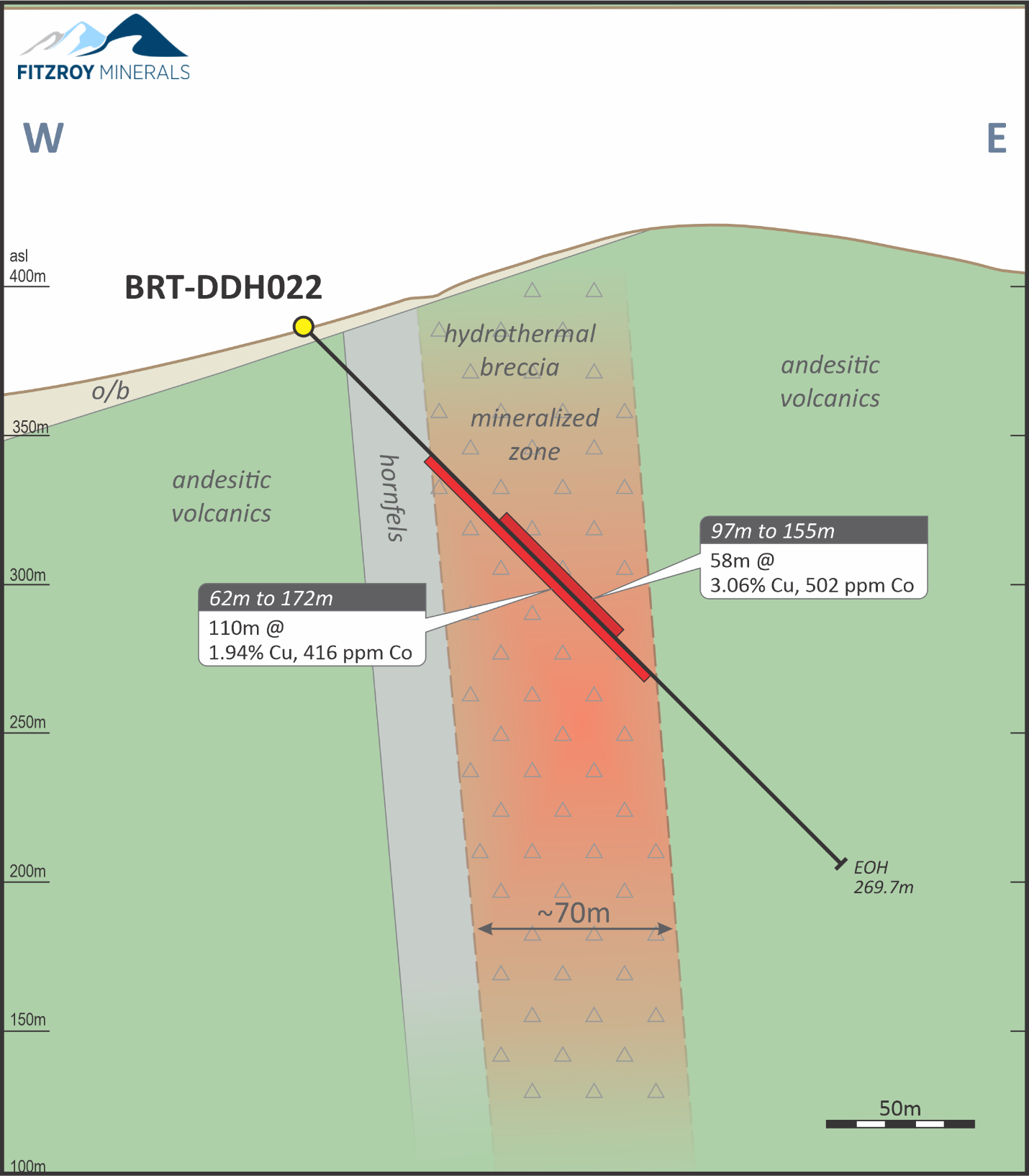
The Southern Area features a north-south magnetic anomaly that extends for over 1 km from the southern edge of the old pit to drill hole BRT-DDH021.
Drill holes BRT-DDH017, BRT-DDH018, and BRT-DDH019 were continued beyond the main oxide targets and into fresh country rock, terminating at lengths of 175 m, 300 m, and 175 m, respectively. All three holes intersected silicified, albitised, and brecciated volcanic andesites with varying amounts of disseminated pyrite and chalcopyrite. BRT-DDH018 was collared further to the east than the main trend, and intersected mineralization from surface, raising the possibility of a new, sub-parallel trend. This upper portion of BRT-DDH018 returned 39 m @ 0.30% Cu, including 7 m @ 0.60% Cu. The true width of the mineralized intercept in holes BRT-DDH017 to BRT-DDH021 is interpreted to be 75% of the reported interval. The pervasive alteration and mineralization underlines the scale and the extent of the copper-mineralizing events at Buen Retiro.
Figure 3. Cross-Section*, North Area, Buen Retiro Copper Project, Chile.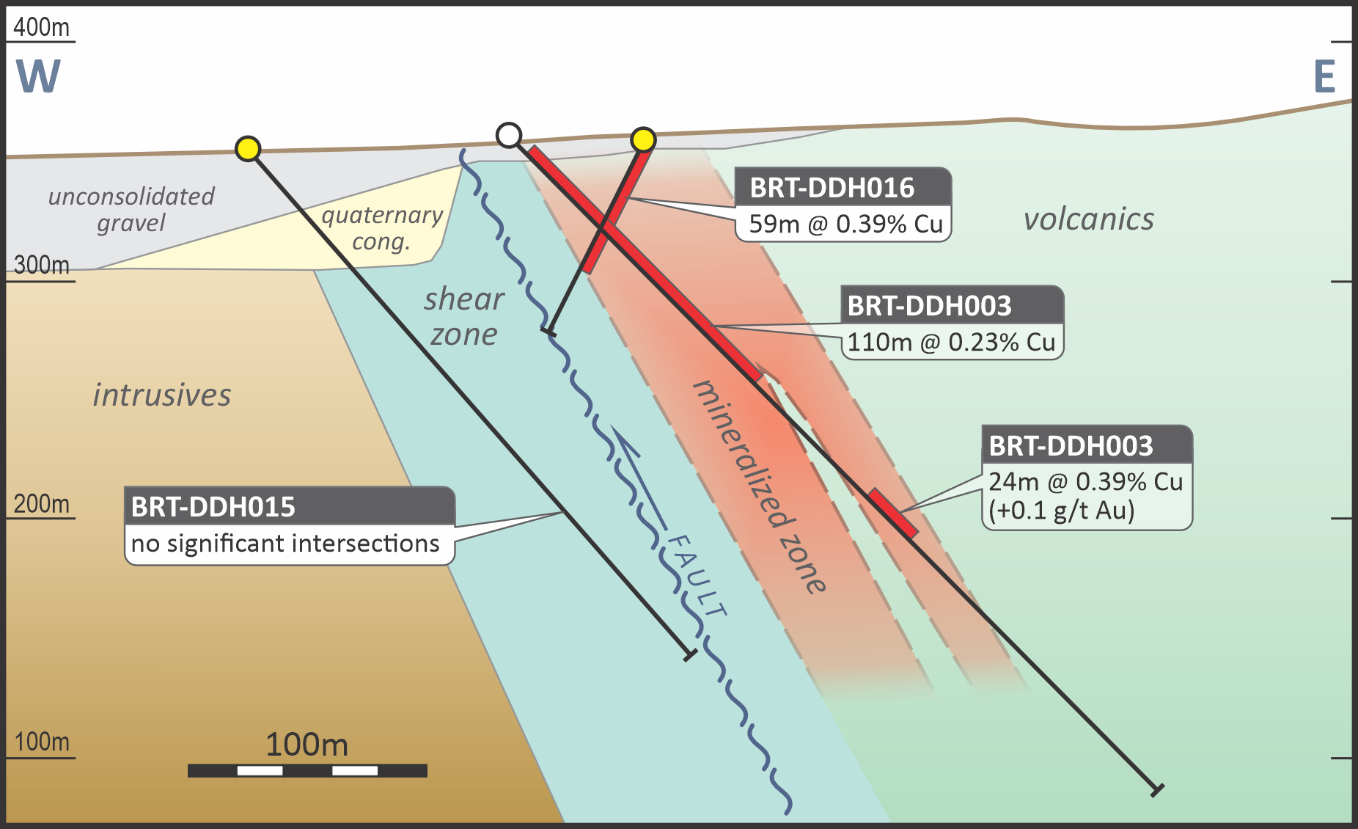
*BRT-DDH003 is located 100 m further south and is projected northward onto this cross-section.
Next Steps
Drilling at Buen Retiro can continue year-round and Fitzroy Minerals aims to complete at least 8,000 m in 2025. Exploration for the remainder of 2025 will largely focus on the Southwest and North areas. Exploration of the Southwest Area will aim to delineate extensions to mineralization along strike and at depth. Exploration in the extensive North Area will focus on shallow drilling under gravel cover; the Company is investigating the use of an RC or DTH rig for this area. Several other areas, such as the Central and South, and wider step-out targets that warrant further attention, will also be explored in due course.
Sampling Procedures, Laboratory and QA/QC
Using a core cutting diamond blade saw, primary half core samples are collected from the NQ-sized drill holes with the remaining half-core stored in the original wooden core trays at the rented core storage warehouse in Cuesta Cardones, south of Copiapó. High-, medium- or low-grade copper standards or a silica blank, are inserted every 20 samples (~20 m); a blank is always inserted immediately after a section with native copper. Pulp duplicates are randomly chosen proportion to the number of samples per drill hole. The sample identifications are changed and coded by the Company. The QA/QC samples prepared by the Company represent about 12% of the total primary core samples.
The three copper standards (both oxide and sulphide), acquired from Chilean company Instituto Nacional de Technologia Estandarizacion y Metrologia Ltda. (“INTEM”) all have international standard certification. The certified standards are used to evaluate the accuracy (approximation versus true value) of the laboratory analysis. Blanks are used to evaluate the quality of the laboratory preparation and identify possible contamination. Pulp duplicates are used to test analytical accuracy (repeatability). No secondary laboratory (referee lab) samples were completed in this round of drilling; however, the next stage and subsequent stages of drilling will put in place laboratory replicate procedures.
The pulps and rejects of crushed samples are collected from the ALS-Patagonia laboratory in Copiapó every 3 months. The rejects are stocked in closed drums, identified with the corresponding batches and sample ranges, while the pulps are stocked in boxes and in shelves inside a container separated for this purpose. Both are located in the same warehouse facilities.
A visual review of the QA/QC results from the standards and blanks inserted by the Company and the laboratory’s internal QA/QC information was completed by the Company and no significant issues were identified.
Qualified Person
Dr. Scott Jobin-Bevans (P.Geo., Ph.D., PMP), a Qualified Person as defined by National Instrument 43-101 and independent geological consultant to the Company, has reviewed and verified the technical information provided in this news release, including the sampling, analytical and test data underlying the technical information contained in this news release. Specifically, the QP verified laboratory assay certificates against the reported drill core intervals as well as drill core logs against the geology, as supplied by the Company.
About Fitzroy Minerals
Fitzroy Minerals is focused on exploring and developing mineral assets with substantial upside potential in the Americas. The Company’s current property portfolio includes the Buen Retiro Copper Project located near Copiapó, Chile, the Caballos Copper and Polimet Gold-Copper-Silver projects located in Valparaiso, Chile, the Taquetren Gold Project located in Rio Negro, Argentina, and the Cariboo Project in British Columbia, Canada. Fitzroy Minerals’ shares are listed on the TSX Venture Exchange under the symbol FTZ and on the OTCQB under the symbol FTZFF.
On behalf of Fitzroy Minerals Inc.
Merlin Marr-Johnson
President and CEO
For further information, please contact:
Merlin Marr-Johnson
This email address is being protected from spambots. You need JavaScript enabled to view it.
+447803712280
For more information on Fitzroy Minerals, please visit the Company's website: www.fitzroyminerals.com
Neither Exchange nor its Regulation Services Provider (as that term is defined in the policies of the Exchange) accepts responsibility for the adequacy or accuracy of this release.
CAUTIONARY STATEMENT REGARDING FORWARD-LOOKING INFORMATION
This news release includes certain statements and information that constitute forward-looking information within the meaning of applicable Canadian securities laws. All statements in this news release, other than statements of historical facts are forward-looking statements. Such forward-looking statements and forward-looking information specifically include, but are not limited to, statements that relate to the potential mineralization on the Company’s mineral properties, future exploration plans on the Company’s mineral properties and the timing and results of future exploration..
Statements contained in this release that are not historical facts are forward-looking statements that involve various risks and uncertainty affecting the business of the Company. Such statements can generally, but not always, be identified by words such as "expects", "plans", "anticipates", "intends", "estimates", "forecasts", "schedules", "prepares", "potential" and similar expressions, or that events or conditions "will", "would", "may", "could" or "should" occur. All statements that describe the Company's plans relating to operations and potential strategic opportunities are forward-looking statements under applicable securities laws. These statements address future events and conditions and are reliant on assumptions made by the Company's management, and so involve inherent risks and uncertainties, as disclosed in the Company's periodic filings with Canadian securities regulators, including without limitation, the dangers inherent in exploration, development and mining activities; actual exploration or development plans and costs differing materially from the Company’s estimates; the ability to obtain and maintain any necessary permits, consents or authorizations required for mining activities; environmental regulations or hazards and compliance with complex regulations associated with mining activities; climate change and climate change regulations; fluctuations in exchange rates; the availability of financing; operations in foreign and developing countries and the compliance with foreign laws, remote operations and the availability of adequate infrastructure; fluctuations in price and availability of energy and other inputs necessary for mining operations; shortages or cost increases in necessary equipment, supplies and labour; regulatory, political and country risks, including local instability or acts of terrorism and the effects thereof; the reliance upon contractors, third parties and joint venture partners; challenges to title or surface rights; the dependence on key personnel and the ability to attract and retain skilled personnel; the risk of an uninsurable or uninsured loss; adverse climate and weather conditions; litigation risk; and competition with other mining companies. As a result of these risks and uncertainties, and the assumptions underlying the forward-looking information, actual results could materially differ from those currently projected, and there is no representation by the Company that the actual results realized in the future will be the same in whole or in part as those presented herein. the Company disclaims any intent or obligation to update forward-looking statements or information except as required by law. Readers are referred to the additional information regarding the Company's business contained in the Company's reports filed with the securities regulatory authorities in Canada. Although the Company has attempted to identify important factors that could cause actual actions, events, or results to differ materially from those described in forward-looking statements, there may be other factors that could cause actions, events or results not to be as anticipated, estimated or intended. For more information on the Company and the risks and challenges of its business, investors should review the Company's filings that are available at www.sedarplus.ca.
The Company provides no assurance that forward-looking statements and information will prove to be accurate, as actual results and future events could differ materially from those anticipated in such statements or information. Accordingly, readers should not place undue reliance on forward-looking statements or information. The Company does not undertake to update any forward looking statements, other than as required by law.


